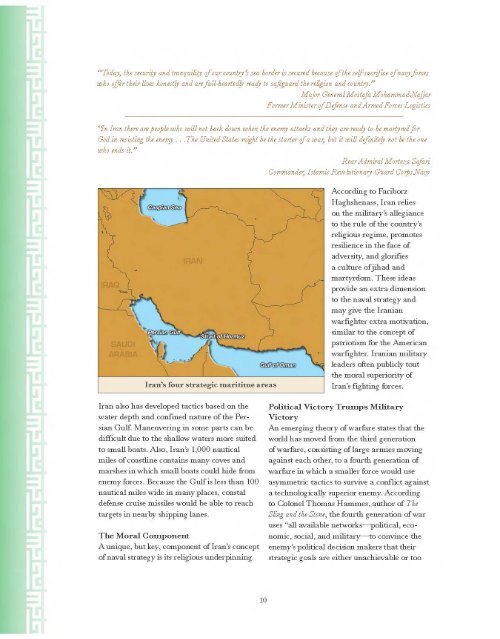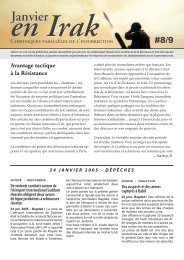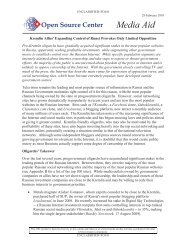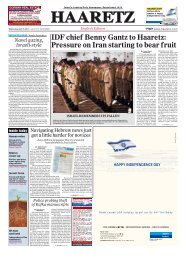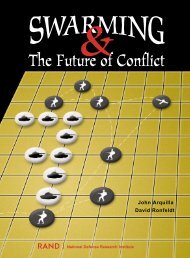Iran's Naval Forces: From Guerilla Warfare to a Modern Naval Strategy
Iran's Naval Forces: From Guerilla Warfare to a Modern Naval Strategy
Iran's Naval Forces: From Guerilla Warfare to a Modern Naval Strategy
Create successful ePaper yourself
Turn your PDF publications into a flip-book with our unique Google optimized e-Paper software.
«Today, the security and tranquility if our country -s sea border is secured because if the se!f-sacrjfiu of na1!J forces<br />
who iffir their lives honestfy and are full-heartedfy rearfy <strong>to</strong> so:foguard the religion and country.»<br />
Major GeneralMostqfa Mohammad-Najjar<br />
Former Minister if Difense and Armed <strong>Forces</strong> Logistics<br />
«In Iran there are people who will not back down when the enemy attacks and they are rearfy <strong>to</strong> be martyredfir<br />
God in resisting the enemy . .. The United States might be the starter if a war, but it will difinitefy not be the one<br />
who ends it.»<br />
Rear Admiral Morteza Sqfari<br />
Commander, Islamic Revolutionary Guard CorpsNa1!J<br />
•<br />
<strong>Iran's</strong> four strategic IllaritiIlle areas<br />
According <strong>to</strong> Fariborz<br />
Haghshenass, Iran relies<br />
on the military's allegiance<br />
<strong>to</strong> the rule of the country's<br />
religious regime, promotes<br />
resilience in the face of<br />
adversity, and glorifies<br />
a culture of jihad and<br />
martyrdom. These ideas<br />
provide an extra dimension<br />
<strong>to</strong> the naval strategy and<br />
may give the Iranian<br />
warfighter extra motivation,<br />
similar <strong>to</strong> the concept of<br />
patriotism for the American<br />
warfighter. Iranian military<br />
leaders often publicly <strong>to</strong>ut<br />
the moral superiority of<br />
<strong>Iran's</strong> fighting forces.<br />
Iran also has developed tactics based on the<br />
water depth and confined nature of the Persian<br />
Gulf. Maneuvering in some parts can be<br />
difficult due <strong>to</strong> the shallow waters more suited<br />
<strong>to</strong> small boats. Also, <strong>Iran's</strong> 1,000 nautical<br />
miles of coastline contains many coves and<br />
marshes in which small boats could hide from<br />
enemy forces. Because the Gulfis less than 100<br />
nautical miles wide in many places, coastal<br />
defense cruise missiles would be able <strong>to</strong> reach<br />
targets in nearby shipping lanes.<br />
The Moral COlll.ponent<br />
A unique, but key, component of <strong>Iran's</strong> concept<br />
of naval strategy is its religious underpinning.<br />
Political Vic<strong>to</strong>ry TrUlll.ps Military<br />
Vic<strong>to</strong>ry<br />
An emerging theory of warfare states that the<br />
world has moved from the third generation<br />
of warfare, consisting oflarge armies moving<br />
against each other, <strong>to</strong> a fourth generation of<br />
warfare in which a smaller force would use<br />
asymmetric tactics <strong>to</strong> survive a conflict against<br />
a technologically superior enemy. According<br />
<strong>to</strong> Colonel Thomas Hammes, author of The<br />
Sling and the S<strong>to</strong>ne, the fourth generation of war<br />
uses "all available networks-political, economic,<br />
social, and military-<strong>to</strong> convince the<br />
enemy's political decision makers that their<br />
strategic goals are either unachievable or <strong>to</strong>o<br />
10


